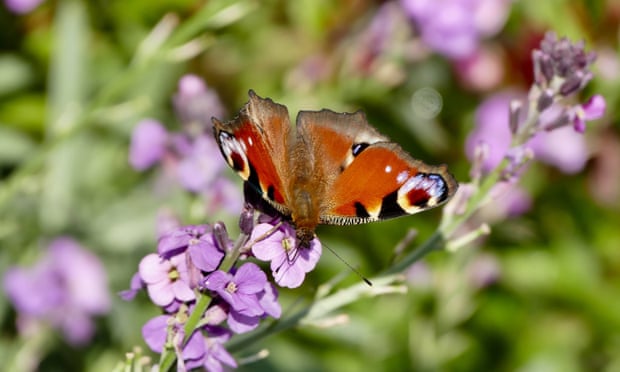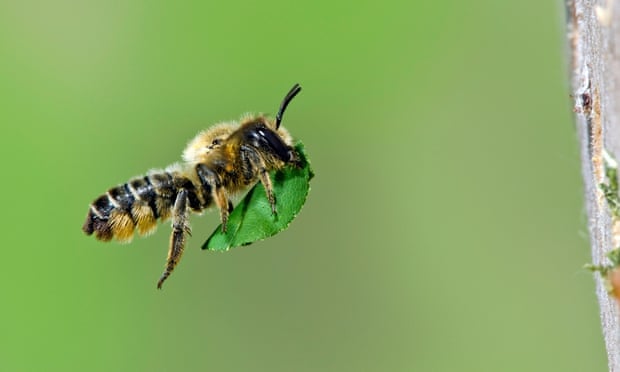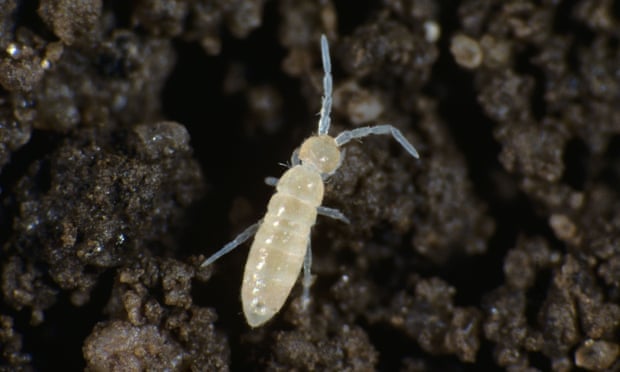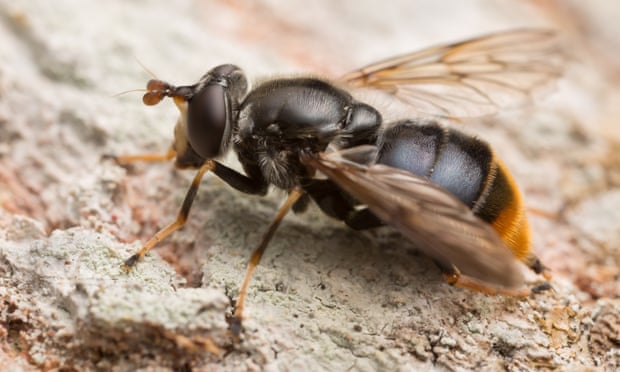May 16, 2025 | 10:46 GMT +7
May 16, 2025 | 10:46 GMT +7
Hotline: 0913.378.918
May 16, 2025 | 10:46 GMT +7
Hotline: 0913.378.918

A peacock butterfly in an Oxfordshire garden. Photo: Geoffrey Swaine/Rex/Shutterstock
I have been fascinated by insects all my life. One of my earliest memories is of finding, at the age of five or six, some stripy yellow-and-black caterpillars feeding on weeds in the school playground. I put them in my empty lunchbox, and took them home. Eventually they transformed into handsome magenta and black moths. This seemed like magic to me – and still does. I was hooked.
In pursuit of insects I have travelled the world, from the deserts of Patagonia to the icy peaks of Fjordland in New Zealand and the forested mountains of Bhutan. I have watched clouds of birdwing butterflies sipping minerals from the banks of a river in Borneo, and thousands of fireflies flashing in synchrony at night in the swamps of Thailand. At home in my garden in Sussex I have spent countless hours watching grasshoppers court a mate and see off rivals, earwigs tend their young, ants milk honeydew from aphids, and leaf-cutter bees snip leaves to line their nests.
But I am haunted by the knowledge that these creatures are in decline. It is 50 years since I first collected those caterpillars in the school playground, and every year that has passed there have been slightly fewer butterflies, fewer bumblebees – fewer of almost all the myriad little beasts that make the world go round. These fascinating and beautiful creatures are disappearing, ant by ant, bee by bee, day by day. Estimates vary and are imprecise, but it seems likely that insects have declined in abundance by 75% or more since I was five years old. The scientific evidence for this grows stronger every year, as studies are published describing the collapse of monarch butterfly populations in North America, the demise of woodland and grassland insects in Germany, or the seemingly inexorable contraction of the ranges of bumblebees and hoverflies in the UK.
In 1963, two years before I was born, Rachel Carson warned us in her book Silent Spring that we were doing terrible damage to our planet. She would weep to see how much worse it has become. Insect-rich wildlife habitats, such as hay meadows, marshes, heathland and tropical rainforests, have been bulldozed, burned or ploughed to destruction on a vast scale. The problems with pesticides and fertilisers, she highlighted, have become far more acute, with an estimated 3m tonnes of pesticides now going into the global environment every year. Some of these new pesticides are thousands of times more toxic to insects than any that existed in Carson’s day. Soils have been degraded, rivers choked with silt and polluted with chemicals. Climate change, a phenomenon unrecognised in her time, is now threatening to further ravage our planet. These changes have all happened in our lifetime, on our watch, and they continue to accelerate.

A leafcutter bee in Hertfordshire. Photo: Nature Picture Library
Few people seem to realise how devastating this is, not only for human wellbeing – we need insects to pollinate our crops, recycle dung, leaves and corpses, keep the soil healthy, control pests, and much more – but for larger animals, such as birds, fish and frogs, which rely on insects for food. Wildflowers rely on them for pollination. As insects become more scarce, our world will slowly grind to a halt, for it cannot function without them.
Increasingly, most of us live in cities, and grow up seeing few insects other than houseflies, mosquitoes and cockroaches, so the majority of us don’t much like insects. Many people are terrified of them. They are often referred to as “creepy crawlies” or “bugs”; unpleasant, scuttling, dirty creatures, living in filth and spreading disease. Few therefore appreciate how vitally important insects are to our own survival, and fewer still how beautiful, clever, fascinating, mysterious and wonderful insects are.
Insects have been around for a very long time. Their ancestors evolved in the primordial ooze of the ocean floors, half a billion years ago. They make up the bulk of known species on our planet – ants alone outnumber humans by a million to one – so if we were to lose many of our insects, overall biodiversity would of course be significantly reduced. Moreover, given their diversity and abundance, it is inevitable that insects are intimately involved in all terrestrial and freshwater food chains and food webs. Caterpillars, aphids, caddisfly larvae and grasshoppers are herbivores, for instance, turning plant material into tasty insect protein that is far more easily digested by larger animals. Others, such as wasps, ground beetles and mantises, occupy the next level in the food chain, as predators of the herbivores. All of them are prey for a multitude of birds, bats, spiders, reptiles, amphibians, small mammals and fish, which would have little or nothing to eat if it weren’t for insects. In their turn, the top predators such as sparrowhawks, herons and osprey that prey on the insectivorous starlings, frogs, shrews or salmon would themselves go hungry without insects.
The loss of insect life from the food chain would not just be catastrophic for wildlife. It would also have direct consequences for the human food supply. Most Europeans and North Americans are repulsed by the prospect of eating insects, which is odd, since we happily consume prawns (which are broadly similar, being segmented, and with an external skeleton). Our ancient ancestors would certainly have eaten insects and, globally, eating insects is the norm. Roughly 80% of the world’s population regularly consume them, with the practice very common in South America, Africa and Asia, and among the indigenous peoples of Oceania.
A strong argument can be made that humans ought to farm more insects as an alternative to pigs, cows or chickens. Farming insects is more energy efficient and requires less space and water. They are a healthier source of protein, being high in essential amino acids and lower in saturated fats than beef, and we are much less likely to catch a disease from eating insects (think bird flu or Covid-19). So if we wish to feed the 10-12 billion people who are projected to be living on our planet by 2050, then we should be taking the farming of insects seriously as a healthier source of protein and a more sustainable option to conventional livestock.
While western societies may not eat insects, we do regularly consume them at one step removed in the food chain. Freshwater fish such as trout and salmon feed heavily on insects, as do game birds like partridge, pheasant and turkey.

An adult springtail. Photo: Nigel Cattlin/Alamy
Aside from their role as food, insects perform a plethora of other vital services in ecosystems. For example, 87% of all plant species require animal pollination, most of it delivered by insects. The colourful petals, scent and nectar of flowers evolved to attract pollinators. Without pollination, wild flowers would not set seed, and most would eventually disappear. There would be no cornflowers or poppies, foxgloves or forget-me-nots. But an absence of pollinators would have a far more devastating ecological impact than just the loss of wild flowers. Approximately three-quarters of the crop types we grow also require pollination by insects, and if the bulk of plant species could no longer set seed and died out, then every community on land would be profoundly altered and impoverished, given that plants are the basis of every food chain.
The importance of insects is often justified in terms of the ecosystem services they provide, which can be ascribed a monetary value. Pollination alone is estimated to be worth between $235bn and $577bn a year worldwide (these calculations aren’t very accurate, hence the wide difference between the two figures). Financial aspects aside, we could not possibly feed the growing global human population without pollinators. We could produce enough calories to keep us all alive, since wind-pollinated crops such as wheat, barley, rice and maize comprise the bulk of our food, but living exclusively on a diet of bread, rice and porridge would quickly see us succumb to deficiencies of essential vitamins and minerals. Imagine a diet without strawberries, chilli peppers, apples, cucumbers, cherries, blackcurrants, pumpkins, tomatoes, coffee, raspberries, courgettes, runner beans and blueberries, to name just a few. The world already produces fewer fruit and vegetables than would be needed if everybody on the planet were to have a healthy diet. Without pollinators it would be impossible to produce anywhere near the “five a day” fruit and veg we all need.
Insects are also intimately involved in the breakdown of organic matter, such as fallen leaves, timber and animal faeces. This is vitally important work, for it recycles the nutrients, making them available once more for plant growth. Most decomposers are never noticed. For example, your garden soil – and particularly your compost heap, if you have one – almost certainly contains countless millions of springtails (Collembola). These minute, primitive relatives of insects, often less than 1mm long, are named for their clever trick of firing themselves as high as 100mm into the air to escape predators. This army of minuscule high-jumpers does an important job, nibbling on tiny fragments of organic matter and helping to break them up into even smaller pieces which are then further decomposed by bacteria, releasing the nutrients for plants to use.
Other insects, the undertakers of the natural world, are similarly efficient at disposing of dead bodies. With uncanny speed, flies such as bluebottles and greenbottles locate corpses within minutes of death, laying masses of eggs that hatch within hours into maggots that race to consume the carcass before other insects arrive. Their relatives, the flesh flies, have an edge in this race, as they give birth directly to maggots, skipping the egg stage entirely. Burying and carrion beetles arrive next and consume both the corpse and the developing maggots. Burying beetles drag the corpses of small animals underground, lay their eggs on them, then remain to care for their offspring. This sequence of events is sufficiently predictable even to be used by forensic entomologists to judge the approximate time of death of human corpses when the circumstances of death are suspicious.
On top of all this, burrowing, soil-dwelling insects help to aerate the soil. Ants disperse seeds, carrying them back to their nests to eat, but often losing a few, which can then germinate. Silk moths give us silk, and honeybees give us honey. In total, the ecosystem services provided by insects are estimated to be worth at least $57bn a year in the US alone, although this is a pretty meaningless calculation since, as EO Wilson once said, without insects “the environment would collapse into chaos” and billions would starve.
The American biologist Paul Ehrlich likened the loss of species from an ecological community to randomly popping out rivets from the wing of an aeroplane. Remove one or two and the plane will probably be fine. Remove 10, or 20 or 50, and at some point that we are entirely unable to predict, there will be a catastrophic failure, and the plane will fall from the sky. Insects are the rivets that keep ecosystems functioning.
Despite dire warnings such as this, insects are far less well studied than vertebrates, and we know essentially nothing about the majority of the 1m species that have so far been named: their biology, distribution and abundance are entirely unknown. Often all we have is a “type specimen” on a pin in a museum, with a date and place of capture. There are estimated to be at least another 4m species we have yet to discover. What a cruel irony it is that, while we are still decades away from cataloguing the staggering insect diversity on our planet, these creatures are fast disappearing.
The figures are stark. In 2015 I was contacted by the Krefeld Society, a group of entomologists who, since the late 1980s, had been trapping flying insects on nature reserves scattered across Germany. They had amassed insects from nearly 17,000 days of trapping across 63 sites and 27 years, a total of 53kg of insects. They sent me their data to ask for my help in preparing it for publication in a scientific journal. In the 27 years from 1989 to 2016 the overall biomass (ie weight) of insects caught in their traps fell by 75%. In midsummer, when in Europe we see the peak of insect activity, the decline was even more marked, at 82%. I thought initially that there must have been some sort of mistake, because this seemed too dramatic a drop to be credible. We knew that wildlife in general was in decline, but for three-quarters of insects to have disappeared so rapidly suggested a pace and scale of decline that had previously not been imagined.
In October 2019 a different group of German scientists published their findings from a study of insect populations in German forests and grasslands over 10 years from 2008 to 2017. The study’s results were deeply troubling. Grasslands fared worst, losing on average two-thirds of their arthropod biomass (the insects, spiders, woodlice and more). In woodlands, biomass dropped by 40%.
What about elsewhere? Is there something peculiar going on in Germany? It seems highly unlikely. Perhaps the best-studied insect populations in the world are the UK’s butterflies. They are recorded by volunteers as part of the Butterfly Monitoring Scheme, the largest and longest-running scheme of its kind in the world. The trends it reveals are worrying. Butterflies of the “wider countryside” – common species found in farmland, gardens and so on, such as meadow browns and peacocks – fell in abundance by 46% between 1976 and 2017. Meanwhile, habitat specialists, fussier species that tend to be much rarer, such as fritillaries and hairstreaks, fell by 77%, despite concerted conservation efforts directed at many of them.
Worldwide, although the bulk of insect species – the flies, beetles, grasshoppers, wasps, mayflies, froghoppers and so on – are not systematically monitored, we often have good data on population trends for birds that depend on insects for food, and these are mostly in decline. For example, populations of insectivorous birds that hunt their prey in the air (ie the flying insects that have decreased so much in biomass in Germany) have fallen by more than any other bird group in North America, by about 40% between 1966 and 2013. Bank swallows, common nighthawks (nightjars), chimney swifts and barn swallows have all fallen in numbers by more than 70% in the past 20 years.
In England, populations of the spotted flycatcher fell by 93% between 1967 and 2016. Other once-common insectivores have suffered similarly, including the grey partridge (-92%), nightingale (-93%) and cuckoo (-77%). The red-backed shrike, a specialist predator of large insects, went extinct in the UK in the 1990s. Overall, the British Trust for Ornithology estimates that the UK had 44m fewer wild birds in 2012 compared with 1970.

The pine hoverfly, the UK’s rarest insect. Photo: Henrik_L/Getty Images
All the evidence above relates to populations of insects and their predators in highly industrialised, developed countries. Information about insect populations in the tropics, where most insects live, is sparse. We can only guess what impacts deforestation of the Amazon, the Congo, or south-east Asian rainforests has had on insect life in those regions. We will never know how many species went extinct before we could discover them.
Halting and reversing insect declines, or indeed tackling any of the other major environmental threats we face, requires action at many levels, from the general public to farmers, food retailers and other businesses, local authorities and policymakers in government. Here in Britain, recent elections and the Brexit debate have seen precious little serious discussion of the environment, despite the compelling evidence that many of the biggest challenges facing humanity in the 21st century relate to our unsustainable overexploitation of our planet’s finite resources.
To save them, we need to act, and act now. We can do this in several ways; some simple, others harder to achieve. First, we need to engender a society that values the natural world, both for what it does for us and for its own sake. The obvious place to start is with our children, encouraging environmental awareness from an early age. We need to green our urban areas. Imagine green cities filled with trees, vegetable gardens, ponds and wild flowers squeezed into every available space – in our gardens, city parks, allotments, cemeteries, on road verges, railway cuttings and roundabouts – and all free from pesticides.
We must transform our food system. Growing and transporting food so that we all have something to eat is the most fundamental of human activities. The way we do it has profound impacts on our own welfare, and on the environment, so it is surely worth investing in getting it right. There is an urgent need to overhaul the current system, which is failing us in multiple ways. We could have a vibrant farming sector, employing many more people, and focused on sustainable production of healthy food, looking after soil health and supporting biodiversity.
Government organisations responsible for wildlife conservation, such as Natural England, should be properly funded, yet have seen huge budget cuts in recent years. Monitoring schemes and research into understanding the causes of insect declines must also be properly government-funded. And the UK should play a leading role in international initiatives to tackle climate change and biodiversity loss, setting an example of best practice for others to follow.
We must improve legal protection for rare insects and habitats. In the UK most insects have no legal protection at present. For example, the last population of the UK’s rarest insect, the pine hoverfly, is threatened by private forestry operations, with no legal recourse. Rare insects should be accorded equal weight to rare birds or mammals. Just because they are small does not make them unimportant.
Our planet has coped remarkably well so far with the blizzard of changes we have wrought, but we would be foolish to assume that it will continue to do so. A relatively small proportion of species have gone extinct so far, but almost all wild species now exist in numbers that are a fraction of their former abundance, subsisting in degraded and fragmented habitats and subjected to a multitude of ever-changing human-made problems. We do not understand anywhere near enough to be able to predict how much resilience is left in our depleted ecosystems, or how close we are to tipping points beyond which collapse becomes inevitable. In Paul Ehrlich’s “rivets on a plane” analogy, we may be close to the point where the wing falls off.
(The Guardian)

(VAN) Fourth most important food crop in peril as Latin America and Caribbean suffer from slow-onset climate disaster.

(VAN) Shifting market dynamics and the noise around new legislation has propelled Trouw Nutrition’s research around early life nutrition in poultry. Today, it continues to be a key area of research.

(VAN) India is concerned about its food security and the livelihoods of its farmers if more US food imports are allowed.

(VAN) FAO's Director-General emphasises the need to work together to transform agrifood systems.

(VAN) Europe is facing its worst outbreak of foot-and-mouth since the start of the century.

(VAN) The central authorities, in early April, released a 10-year plan for rural vitalization.

(VAN) Viterra marked a significant milestone in its carbon measurement program in Argentina, called Ígaris, reaching 1 million soybean hectares measured.